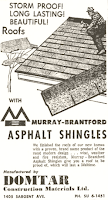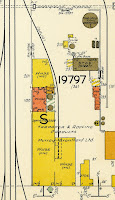
Above: Google Maps
Place: Former Dominion Tar and Chemical Warehouse
Address: 563 rue Messier
Built: 1923, 1930, 1959.
June 22, 1912, Winnipeg Tribune
The Dominion Tar and Chemical Company, (now known as Domtar), was formed in England in 1848. In 1903, it set up shop in Canada to process the tar products from a Sydney, Nova Scotia coal and steel mine.
Domtar came to Manitoba in 1911 after being awarded a ten-year contract by the CPR to creosote two-million railway ties per year. It set up a creosote manufacturing plant on a 110-acre site in North Transcona.
In summer 1923, the company looked at properties in St. Boniface on which to build a new $250,000 chemical manufacturing and tar distilling plant. Initially, a site on Dawson Road was chosen but the company found that it would be too costly to bring in the rail access they required.
Attention then turned to this site on Messier. It had been owned by the City of St. Boniface for a number of years due to non-payment of taxes and was located adjacent to the existing CPR line that runs to Emerson.
Some expressed concerns that the site may be situated too close to St. Boniface Hospital and that the odours would impact recovering patients. That debate appears to have been short-lived as the city was anxious to sell.
In December 1923, Domtar president Sir Harold Boulton toured the proposed site, (which included land on both sides of Messier) and signed the $4,000 purchase agreement with the city.
July 25, 1925, Winnipeg Tribune
It's difficult to piece together the development of the site, though it appears to have been a very scaled-down version of what Dominion Tar first envisioned.
This could have been due to the hospital concerns or the fact that the company was continually buying up smaller companies in the city which may have negated the need for certain new facilities.
Through 1924, it appears that the Messier Street site contained just a warehouse and some tar storage tanks.
In July 1925, permits were taken out for the Messier Street site to build a $28,000 plant to manufacture tar paper, used mainly in the roofing industry.
October 3, 1929, Manitoba Free Press
By October 1929, the company was advertising coke that was made in St. Boniface. Coke, most often used as a heating product, is created by baking coal at extremely high temperatures in a furnace or kiln. This burned off the impurities leaving a heavier carbon product.
The address in the coke ad is the part of the Domtar site across the street from the tar paper factory and warehouse. (This separation was likely intentional as Domtar suffered a massive blaze in Transcona in 1913 when a furnace caught fire, spread to tethir starage areas and burned for days.)
On August 9, 1930, a small story in the Winnipeg Tribune says that “Construction work on the new Winnipeg coal tar and asphalt roofing plant of Dominion Tar is making rapid process", suggesting the operations were expanded.
December 8, 1962, Winnipeg Free Press
In 1929, a Canadian company, also called Dominion Tar and Chemical Company, headquartered in Montreal, was created to take over the assets of the existing British company.
Over the next three decades, Domtar grew into a national powerhouse involved in a range of sectors, from its traditional chemical and tar business to pulp and paper production and building materials manufacturing. Much of this growth was done through the acquisition of existing companies.
In Winnipeg, it was Domtar's building materials division had the largest footprint.
In 1954, it purchased Brantford Roofing Ltd. of Brantford, Ontario, which manufactured roofing materials such as sheathing and shingles. They also purchased Alexander Murray Ltd. of Toronto, (and a neighbour on Messier Street since the early 1920s), which owned a Winnipeg-based shingle manufacturer called Canada Roof Products.
In the late 1950s, the two companies were merged into Murray-Brantford Ltd.. It had a sales office in Transcona, likely at Domatar's administration building, and the Messier property became their warehouse.
ca. 1959 (Source: Manitoba Historical Maps)
The above 1959 map shows the layout of the site, which is similar to how it looks today.
It is likely that at least a portion of the long, steel-clad building along the tracks dates back to the original 1925 - 30 build and was added to over time. The wooden yard office may be as late as 1959, as that is the year that its address first appears in the Henderson Directory.
May 4, 1963, Winnipeg Free Press
Dominion Tar's continued acquisition of companies through the 1950s provided it with a vast, national network of over 50 plants and 40 warehouses in 47 cities across Canada, (source).
Through the 1960s, it merged this network into a single company that in 1965 was renamed Domtar Ltd, then, in 1977, simply Domtar.
During this period, one of the company's new, major properties in Winnipeg was a gypsum plant and adjacent property at 1405 Sargent Avenue at St. James Street. In 1962, the Messier warehouse site was moved to Sargent Avenue and the property was put up for sale. It remained vacant until at least 1966.
It is now home to Magnet Machinery Ltd., a steel recycling company.
July 13, 1981, Winnipeg Free Press
In the end, 40,000 tonnes of earth were removed and trucked to a landfill. Though it is still on the province's contaminated list, it was remediated enough to become the Transcona Community BioReserve.
The rue Messier site is not listed as a contaminated site.
Related:
Domtar History Domtar Inc.
Dominion Tar and Chemical Company Canadian Register (1959)
Past sins haunt St. B Winnipeg Free Press







No comments:
Post a Comment